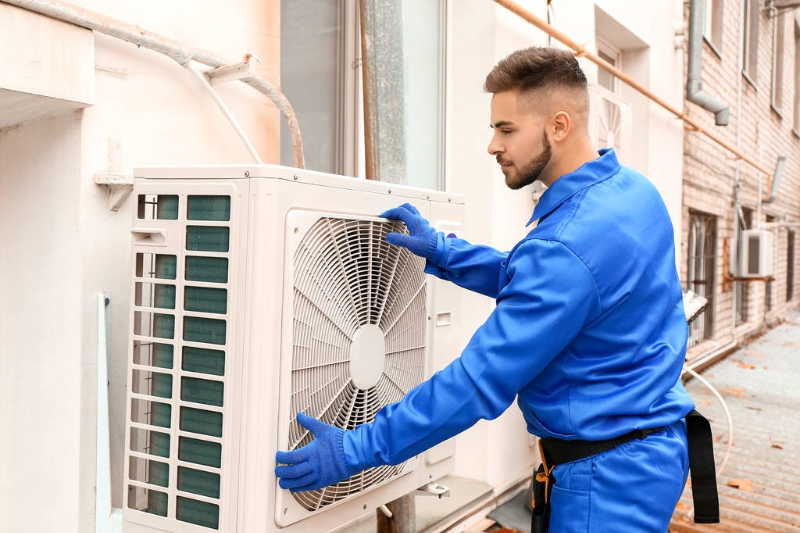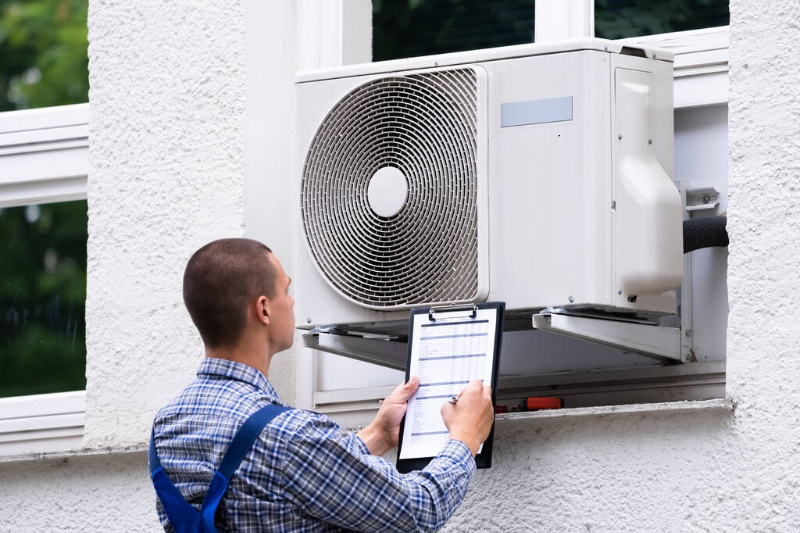Table Of Contents
Regarding apartment living, staying cool during sweltering summers or managing temperature fluctuations throughout the year is crucial for comfort and well-being. Selecting the proper air conditioning (AC) system for your apartment can significantly impact your living experience.
With various options and brands available, it’s essential to consider several factors to determine the best fit for your residential or commercial space and lifestyle. In this guide, we will explore the factors you need to consider before making a decision, delve into popular cooling technologies, discuss how to determine the appropriate BTU for your space, and explore intelligent features.
We will also look at technology integration, and touch upon the cost considerations to help you make an informed choice for the best air conditioning solution for your apartment. Let’s dive in!
Choosing an Air Conditioning System

Apartment size
One of the first considerations when choosing an AC system is the size of your apartment. The square footage will influence the cooling capacity needed to maintain a comfortable indoor environment. Larger apartments require more robust systems to effectively cool the entire space, while smaller units may suffice for more compact layouts.
Energy Efficiency Ratings(EER)
Look for AC units with high Energy Star ratings, indicating their ability to operate efficiently and reduce energy consumption. Energy-efficient models help lower utility bills and contribute to sustainable living practices.
Installation constraints
Some systems, like split system air conditioners, may require professional installation and modifications to accommodate indoor and outdoor components. Conversely, portable or window units offer more flexibility and ease of installation, making them suitable for apartments with limited space or strict installation regulations.
Noise levels
When choosing an AC system, pay attention to noise levels during operation. Some units are designed to operate quietly, particularly for bedrooms or living areas where noise disturbances can affect comfort and relaxation.
Maintenance requirements
Regular maintenance is vital in keeping your AC system running smoothly and efficiently. Consider the maintenance requirements of different systems, including filter replacement, cleaning, and professional air conditioning servicing. Units with easy access to filters and components make maintenance tasks more manageable, ensuring optimal performance and longevity of the system.
Popular Cooling Technologies for Apartments
Split system air conditioners

They consist of indoor and outdoor units connected by refrigerant lines. The indoor division is mounted on the ceiling or wall, while the outdoor unit is outside the apartment. These split systems offer efficient cooling and heating, with the flexibility to control temperatures in individual rooms.
Window air conditioners
Window air cons are self-contained units installed directly into a window or wall opening. They are a popular choice for apartments due to their affordability and ease of installation. Window units are available in various sizes to accommodate different room dimensions, providing adequate cooling for single or small apartments.
Portable air conditioners
They are versatile units that can be moved from room to room. They typically consist of a single unit with exhaust hoses that vent hot air outside through a window or sliding door. A portable air conditioner is immaculate for apartments where permanent installation may not be feasible, offering quick and easy cooling solutions for different living space areas.
Ductless mini-split systems
Ductless mini-split systems air cons operate similarly to traditional split systems but do not require ductwork. Unlike ducted air conditioning systems, they install individual air handlers in each room to deliver conditioned air directly. Ductless air conditioning systems offer energy-efficient cooling and heating, with customisable zoning options to control temperatures in specific apartment areas.
Through-the-wall air conditioners
Through-the-wall air conditioners are installed directly into an exterior wall, similar to window units, but without obstructing window views. These systems are suitable for apartments with specific architectural constraints or where window installation is impossible. Through-the-wall ACs provide efficient cooling and heating, with options for integrated sleeve units or standalone models.
Understanding BTU Requirements for Apartments

Calculating BTU based on square footage
British Thermal Units (BTUs) measure cooling capacity, indicating the quantity of heat an AC system can remove from a space per hour. To determine the appropriate BTU rating for your apartment, calculate the square footage of the area to be cooled and match it with the corresponding BTU capacity recommended for efficient cooling.
Considering ceiling height
Ceiling height can impact the cooling requirements of an apartment, as higher ceilings may require additional BTUs to compensate for increased air volume. Consider the ceiling height when calculating BTU requirements to ensure optimal cooling performance and comfort throughout the living space.
Factoring in insulation
The level of insulation in your apartment can affect its thermal efficiency and cooling load. Well-insulated apartments retain cool air more effectively, reducing the workload on the AC system. Consider the insulation quality when determining BTU requirements, as adequately insulated spaces may require fewer BTUs for efficient cooling.
Accounting for sunlight exposure
Sunlight exposure can contribute to heat gain in your apartment, primarily through windows and doors facing direct sunlight. Rooms with significant sunlight exposure may require higher BTU capacities to offset heat influx and maintain comfortable indoor temperatures. Consider the orientation of your apartment and the amount of sunlight it receives when calculating BTU requirements.
Adjusting for kitchen heat
Kitchens can generate additional heat from cooking appliances, affecting the overall cooling load of your apartment. When calculating BTU requirements, consider the heat generated in the kitchen area to ensure sufficient cooling capacity for the entire living space. Proper ventilation and airflow management can also help mitigate heat buildup in the kitchen.
Smart Features and Technology Integration

Wi-Fi connectivity
Many modern AC systems offer Wi-Fi connectivity, allowing remote control and monitoring via smartphones or smart home devices. Wi-Fi-enabled features provide convenience and flexibility, allowing you to adjust settings, schedule cooling cycles, and monitor energy usage from anywhere.
Programmable thermostats
Programmable thermostats enable you to set customised cooling schedules based on your routine and preferences. These thermostats automatically adjust temperature settings to maximise comfort and energy efficiency, helping you save on utility costs while ensuring optimal indoor comfort.
Energy-saving modes
Energy-saving modes optimise AC performance to reduce energy consumption without sacrificing comfort. These modes may include eco-friendly settings, sleep mode, or adaptive temperature control, which adjusts cooling levels based on occupancy and ambient conditions to minimise energy usage during periods of lower demand.
Compatibility with smart home systems
AC systems integrating with smart home ecosystems offer seamless interoperability with other smart devices and platforms. This integration enables centralised control and automation, allowing you to create customised cooling scenarios and incorporate AC operation into broader smart home routines for enhanced comfort and efficiency.
Mobile app control
Mobile apps provided by AC manufacturers allow intuitive control and management of your cooling system from your smartphone or tablet. With mobile app control, you can remotely adjust temperature settings, monitor energy usage, receive maintenance alerts, and access advanced features and settings for personalised comfort and convenience.
Cost Considerations and Budgeting

Upfront costs of different AC systems
The cost of purchasing and installing an AC system varies depending on the unit’s type, brand, and specifications. Consider your budget constraints and weigh the initial investment against the long-term benefits and performance of different AC systems to determine the most cost-effective option for your apartment.
Operational costs and energy efficiency
In addition to upfront costs, consider the ongoing operational costs of running an AC system. Energy-efficient models may have higher initial costs. However, they offer long-term savings through reduced energy consumption and lower utility bills. Compare energy efficiency ratings and estimated annual operating costs to make informed decisions about the overall cost of ownership.
Potential rebates and incentives
Explore potential rebates, incentives, and tax credits offered by government agencies or utility providers for installing energy-efficient AC systems. These financial incentives can help offset upfront costs and enhance the overall cost-effectiveness of your chosen air conditioning solution.
Long-term investment vs. initial expense
View your AC system as a long-term investment in comfort and energy efficiency. While lower-priced units may be attractive initially, higher-quality and more efficient systems can provide better performance and durability over time. Consider the long-term benefits when evaluating the overall value of different AC options.
Cost of professional installation vs. DIY options
Factor in the cost of installation when budgeting for your AC system. Some systems, like split units or ducted air conditioners, may require professional installation, adding to the overall expense.
On the other hand, portable and window units often allow for DIY installation, potentially reducing upfront costs. Consider your comfort level with installation tasks and the specific requirements of each AC system to make an informed decision that aligns with your budget and preferences.
Elevate Your Apartment Comfort with the Right AC
Enhance your apartment living experience by choosing a suitable air conditioning system tailored to your needs. The possibilities are diverse, from efficient cooling technologies to smart features and budget-friendly options.
Take the next step in creating a cool and comfortable haven – invest in the best air conditioning for your apartment by contacting professional air conditioning contractors today. Your optimal indoor environment awaits!



